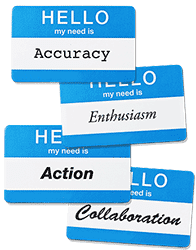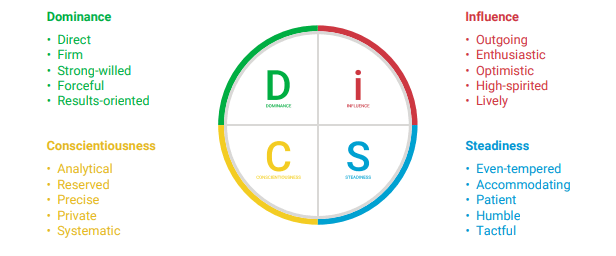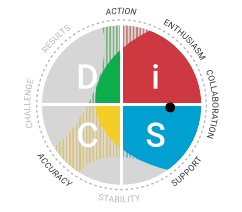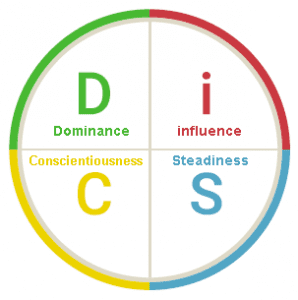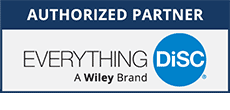In the world of personality assessments, the DiSC model has gained significant popularity for its ability to help people understand themselves and others. The DiSC assessment is easy to use and breaks down four primary personality styles: Dominance, influence, Steadiness, and Conscientiousness. Today, we’re going to dive into the i style, or Influence Personality Type – the energetic, social, and relationship-driven force that brings excitement to any environment.
What is the i Style?
Individuals who have taken the DiSC assessment and find themselves as having the Influence Personality Type, are natural communicators. They are often characterized by their enthusiasm, optimism, and passion for connecting with people. They thrive in social situations and are typically seen as the life of the party. Their contagious energy inspires and motivates those around them.
People with the influence personality type are driven by relationships, recognition, and freedom of expression. They value collaboration, persuasion, and emotional intelligence over strict rules and structure. Their outgoing nature makes them exceptional at building teams and getting people on board with new ideas.
Key Characteristics of the Influence Personality Type
- Outgoing & Expressive: People with this style are usually talkative and open. They enjoy sharing their thoughts and feelings and find it easy to engage with new people.
- Persuasive & Influential: As the name suggests, those with the i style excel in persuading and motivating others. They are natural salespeople who use their charm to win people over to their side.
- People-Oriented: Relationships are central to the i style. They tend to focus on personal interactions, valuing teamwork and collaboration over working in isolation.
- Energetic: They infuse energy and excitement into the workplace and social gatherings, creating lively and dynamic atmospheres.
Strengths of the Influence Personality Type
The i style brings many strengths to the table, especially in situations that require social interaction, team-building, and creativity. Some of the standout strengths include:
- Inspiration & Motivation: These individuals are excellent at rallying others around a cause or project. Their energy inspires those around them to perform at their best.
- Creative Problem Solving: Because they think outside the box and are comfortable with change, the i style is good at coming up with creative solutions to problems.
- Building Relationships: With their natural charm and ability to connect, people with the i style are great at networking and fostering positive relationships within a team or organization.
Areas for Growth
While people with influence are brimming with strengths, there are a few areas where they may face challenges. Understanding these potential blind spots can help i style individuals grow both personally and professionally:

- Overcommitting: Their enthusiasm for involvement can lead to taking on too many projects.
- Disorganization: A focus on relationships might cause neglect of organization and attention to detail.
- Avoidance of Conflict: The i style tends to avoid conflict in an effort to maintain harmony in relationships. This can lead to unresolved issues or a lack of honest feedback.
- Need for Approval: Because they thrive on recognition and affirmation, individuals with the i style may struggle with criticism or fear rejection.
How to Interact with the Influence Personality Type
When you work with the i style, there are a few strategies that can enhance interactions:
- Be Enthusiastic: Matching their energy keeps them engaged and motivated.
- Focus on Relationships: Build trust and rapport is essential, as they value personal connections.
- Offer Positive Feedback: Recognition is key for the i style, so acknowledge their contributions and offer praise where due.
- Allow for Creativity: Give them space to brainstorm and come up with innovative ideas. They excel in environments that encourage free expression.
Maximizing the Potential of the i Style in the Workplace
In the workplace, the i style can be a huge asset in roles that involve communication, customer relations, and team leadership. They are excellent in positions where they can interact with others and use their influence to bring about positive outcomes. Encouraging people with this style to take on roles in sales, marketing, public relations, or team building can help them truly shine.
For managers, it is important to keep in mind that those with the i style will perform best in environments that are collaborative and open. Providing them with positive feedback and allowing for flexibility will not only make them feel appreciated but will also encourage them to excel.
Final Thoughts
Understanding the influence personality type through the DiSC assessment helps us see the value of optimism and energy in both personal and professional settings. By recognizing the strengths and challenges of the i style, we can better appreciate the power of connection and inspiration they bring to any team or organization.
Explore other posts in this 4-part series:
- Discovering the D Style: Dive into the Dominant Personality Type
- Steady and Supportive: Discovering the DiSC Personality Type S
- Discovering the C Personality Type: Conscientiousness at Work
If you would like to learn more about your personality type, or the personality types of your team, consider Everything DiSC Workplace.

